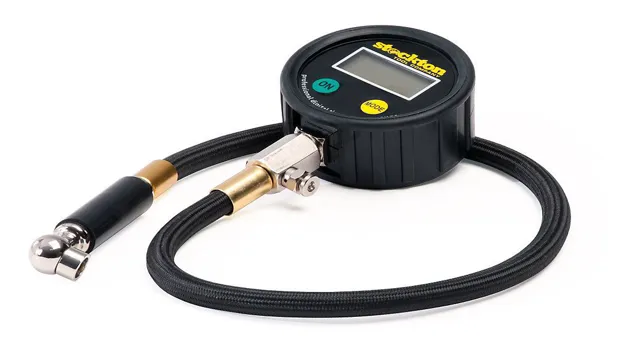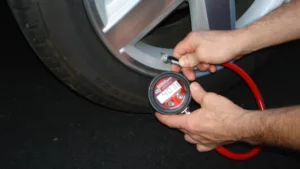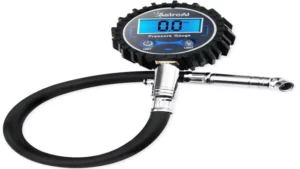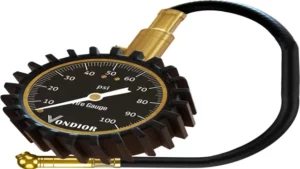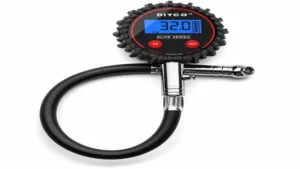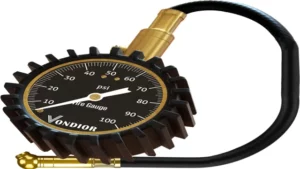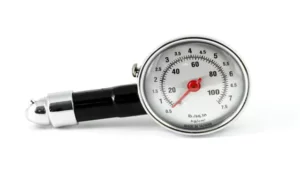When was the last time you checked your tire pressure? If you think it’s not a big deal, think again. Proper tire pressure not only ensures safety while driving but also improves fuel efficiency and prolongs the lifespan of your tires. That’s why it’s essential to have a reliable tire pressure gauge.
In this blog, we’re going to tell you everything you need to know about using a digital tire pressure gauge and how it can make maintaining your tires a breeze. So buckle up and let’s roll!
Step-by-Step Guide
If you’re looking for an accurate and easy way to check your tire pressure, a digital tire pressure gauge can be a great tool to have on hand. To use one, simply turn on the gauge and unscrew the valve cap on your tire. Press the gauge onto the valve stem and hold it in place until the reading stabilizes.
Make note of the measurement and repeat the process with all four tires. If any tire is below the recommended pressure, use an air compressor to inflate it to the proper level. Using a digital tire pressure gauge can save you time and money by preventing wear and tear on your tires and improving your vehicle’s fuel efficiency.
So next time you’re getting ready for a road trip or just want to ensure optimal tire performance, don’t forget to grab your trusty digital tire pressure gauge.
Step 1: Determine the Recommended Pressure
If you want to make sure that your vehicle’s tires perform their best, it’s a good idea to check their pressure at least once a month. The first step in this process is to determine the recommended pressure for your specific tires. This information can usually be found in your vehicle’s owner’s manual or on a sticker located on the doorjamb of the driver’s side door.
It’s important to note that the recommended pressure for your tires may be different from what is printed on the tires themselves, so make sure to double-check this information. Once you have the recommended pressure, you can begin checking your tires for any signs of wear or damage before adjusting their pressure. This can help you identify any potential issues early on and ensure that you’re maintaining your tires properly.
Taking these steps can help extend the life of your tires and improve your overall driving experience on the road.
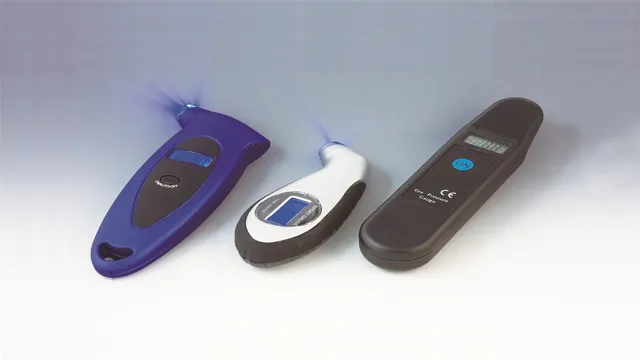
Step 2: Turn on the Digital Tire Pressure Gauge
Turning on a digital tire pressure gauge is a simple process that can be done in a few steps. First, make sure that the gauge is switched off before pressing the power button. Once turned on, it is essential to ensure that the gauge is set to the right setting.
This can be done by pressing the mode button and selecting the correct units, either PSI or bar, depending on your preference. Once the correct setting has been selected, you can then attach the gauge to the tire valve stem and wait for the reading to stabilize. It’s important to note that you may have to adjust the positioning of the gauge a few times to get an accurate reading.
Using a digital tire pressure gauge is an excellent way to ensure that your tires are not under or over-inflated, which can significantly impact your car’s performance and safety on the road.
Step 3: Place the Gauge on the Valve Stem
Placing the tire gauge on the valve stem is the crucial step in checking the air pressure of your car tires. Once you have located the valve stem, remove the valve cap and press the gauge firmly onto the stem. You should hear a hiss of air, indicating that you have made a secure connection.
Hold the gauge onto the stem for a few seconds, and then remove it to read the pressure level. Remember to repeat this process for each tire on your car. Proper tire pressure is essential for stability, handling, and fuel efficiency, so it is an important step in maintaining your vehicle.
Don’t forget to replace the valve caps and record your readings in case you need to refer to them later. Checking your tire pressure regularly will help ensure a smoother and safer ride on the road.
Step 4: Read the Pressure Display
After attaching the pressure gauge to the tire valve stem and setting the correct PSI, it’s time to read the pressure display. The pressure gauge’s display will show the current pressure reading, usually in PSI units. The display will indicate the tire’s pressure reading by a bar that will move across a scale bar on the gauge.
If the tire’s pressure is within the recommended range, the bar will settle at a point in the green zone. If the tire’s pressure is low, the bar will settle in the yellow or red zone. It is recommended to check the pressure of all tires, including the spare regularly.
If your tire’s pressure reading falls beyond the recommended range, you must inflate or deflate your tires accordingly. Remember that maintaining the proper tire pressure will improve fuel efficiency, handling and ensure your safety on the road. So, check your tire pressure regularly, especially before going on a long trip, and keep your car running smoothly.
Tips and Tricks
If you’re not familiar with using a digital tire pressure gauge, don’t worry! It’s actually quite easy. First, make sure your vehicle has been sitting for a while and hasn’t been driven recently. Then, remove the valve stem cap from one of your tires.
Next, attach the end of the gauge to the valve stem and hold it in place until the gauge displays a reading. The reading will show you the current pressure in your tire in PSI (pounds per square inch). If the reading is too low, use an air compressor to fill the tire to the recommended PSI level for your vehicle.
Repeat this process for all four tires. Remember to check your tire pressure regularly, as driving on underinflated tires can be dangerous and can decrease your fuel efficiency. By using a digital tire pressure gauge, you’ll be able to make sure your tires are always at the optimal pressure level, keeping you and your vehicle safe on the road.
Tip 1: Check Your Tires Regularly
As a driver, it’s essential to check your tires regularly. Your tires are the only part of your vehicle that makes contact with the road, so it’s crucial to ensure they’re in top working condition. Start by checking your tire pressure weekly as underinflated tires can create a host of problems, including decreased gas mileage and less tire life.
Another important thing to look for is uneven wear or bald spots on your tires, which could be a sign of misaligned wheels or other problems. When driving, always be mindful of how your car handles, as changes in handling could indicate issues with your tires. So, make it a habit to inspect your tires and keep them in excellent condition for safe driving on the road.
Remember, proper tire maintenance is vital, not only for your safety but also for the longevity of your vehicle. Keyword: check your tires regularly
Tip 2: Test Your Gauge’s Accuracy
One of the most important things to consider when using a pressure gauge is its accuracy. A pressure gauge that doesn’t provide an accurate reading can lead to serious safety concerns when working with pressurized systems. That’s why it’s important to test your gauge’s accuracy before use.
Fortunately, testing your gauge is a relatively simple process. First, you’ll need a known reference pressure source, such as a calibration pump. Hook your gauge up to the pump and compare the reading to the pump’s known pressure.
If the readings match, your gauge is accurate. If they don’t, you may need to have your gauge calibrated or replaced. Remember, accuracy is key when it comes to pressure gauges, so always test your gauge before use to ensure your safety.
Conclusion
Using a digital tire pressure gauge is simple and easy. First, ensure that your tires are cool before taking the reading. Then, firmly press the gauge onto the valve stem and wait for the reading.
If the reading is too low, inflate your tires to the recommended pressure. If it’s too high, release some air until you reach the correct pressure. Remember, a properly inflated tire ensures better fuel efficiency, a smoother ride, and extends the lifespan of your tires.
So, don’t be a deflated driver – use a digital tire pressure gauge and keep your ride in top form!”
FAQs
What is a digital tire pressure gauge and how does it work?
A digital tire pressure gauge is an electronic device that measures the air pressure inside your vehicle’s tires. To use it, simply press the gauge onto the tire valve stem and it will display the pressure reading on its screen.
How accurate are digital tire pressure gauges?
Digital tire pressure gauges are generally considered to be more accurate than analog gauges. However, it’s important to choose a high-quality gauge and calibrate it periodically to ensure accuracy.
Can a digital tire pressure gauge be used on all types of tires?
Yes, digital tire pressure gauges can be used on all types of tires, including those on cars, trucks, motorcycles, bicycles, and more.
Is it necessary to use a digital tire pressure gauge instead of a traditional gauge?
While a traditional gauge can give you an accurate reading of your tire pressure, a digital gauge is often easier to read and can provide more precise measurements. Additionally, digital gauges may offer features such as automatic shut-off and backlit screens for use in low-light conditions.
How often should I check my tire pressure with a digital gauge?
It’s recommended that you check your tire pressure at least once a month, or more frequently if you notice any changes in your vehicle’s handling or fuel efficiency. Using a digital gauge can make this task quick and easy.
Are there any safety precautions I should take when using a digital tire pressure gauge?
Always read and follow the manufacturer’s instructions for your specific gauge. Be sure to use the gauge on a flat surface and hold it securely onto the valve stem to ensure an accurate reading. Also, use caution when removing the gauge from the tire to avoid accidentally deflating the tire.
What should I do if my digital tire pressure gauge is not working properly?
If you’re having trouble getting an accurate reading with your digital gauge, try replacing the battery or resetting the gauge according to the manufacturer’s instructions. If the problem persists, you may need to have the gauge repaired or replaced.
